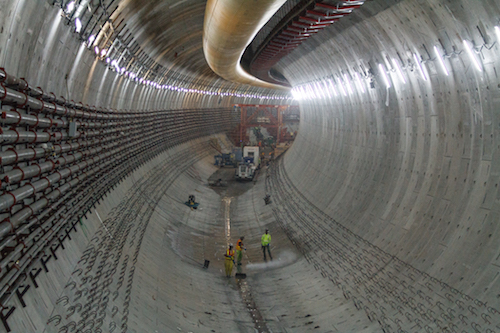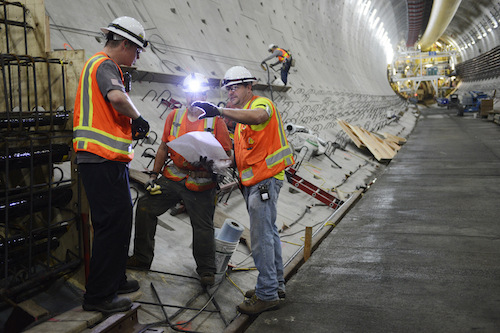Bertha is a very big part of a very big project, and Seattle
Local 46 members are helping to steer her, and the project, to the finish line.

|
The near 58-foot diameter of the boring machine’s cutterhead is constructing a tunnel that will be nearly two miles long and carry traffic in two directions, double-decker style.
|
Just over 100 members are working on the $2 billion digging portion of the project that involves building a two-mile long tunnel under downtown Seattle using a tunnel boring machine, nicknamed Bertha. The tunnel will ferry traffic under the city instead of through it, replacing an elevated highway that has bisected the city for the past 50 years.
“We’re basically putting a highway in a tube, underground,” said Local 46 Business Representative Keith Weir.
Once complete, the tunnel will carry two lanes of traffic in each direction, double-decker style, as part of State Route 99.
Named after the city’s first female mayor, Bertha Knight Landes who served in the 1920s, the specially-built cylindrical machine excavates the path while removing soil and rock. The tunnel is part of a larger, $3 billion project to rebuild the Alaskan Way Viaduct, including construction of an overpass, a new surface street and revamping the downtown waterfront. It’s the most progressive infrastructure project Seattle has seen in generations.
“Without the viaduct, there will be more economic activity, more opportunity for more construction for our members,” Weir said. “The city can build more high-rises and businesses, and all the traffic will be underground.”
Bertha will have traveled just over 9,200 feet, at times as far as 200 feet underground, by the time she reaches the endpoint, expected to be this spring. The tunnel is scheduled to open for traffic in 2019. The entire project, which began in 2007, will be complete in 2023.
Local 46 members have worked on underground and tunnel projects with Sound Transit, Seattle’s public transportation system, as well as wastewater projects for the past two decades, Weir said. As far as size however, Bertha holds the title.
With a cutterhead diameter of almost 58 feet, Bertha weighs in at 6,100 tons and comes with an $80 million price tag. The machine has two erector arms that line the walls with concrete segments, forming rings. Typically there is only one arm, but due to Bertha’s size two were built.
“When you take someone down there who’s never been in a tunnel that size before, it’s overwhelming,” said superintendent and Las Vegas Local 357 member Buck Osborne who was brought in for the project.
“She’s about the length of a football field,” Weir said. “Bertha is really a city unto herself.”
Building Opportunity
Members supply all electrical aspects to the infrastructure project. They provide electricity to the tunnel itself as well as temporary power for lighting and ventilation. Crews are also installing the electrical systems that will be in place once the tunnel opens to traffic, including lighting, communications and fire alarms. And they provide the 26,000 volts that power Bertha.

|
Members of Seattle Local 46 are working on a massive infrastructure project that involves powering one of the largest tunnel boring machines in the world.
|
“This is a unique project,” said journeyman wireman and Local 46 member Aman Krishna. “I’m proud to be a part of it.”
Built in the 1950s, the viaduct was damaged by 6.8-magnitude earthquake in 2001. The new tunnel will be able to withstand temblors up to 9.0.
The project has experienced some setbacks. Bertha had to undergo unexpected repairs for overheated bearings in December 2013, shortly after tunneling began. Osborne was part of the repair team.
“It was very tedious and time-consuming,” he said of the two-year process that required disassembling the 2,000-ton front end in a pit more than 100 feet underground and bringing it to the surface.
In January 2016, a sinkhole formed, halting excavation once more. The project started again a month later.
Bertha has been tunneling away since then, and IBEW signatory contractor Fisk Electric has kept the crew working throughout, Weir said.
“It’s fun to think that in the future, I’ll get to tell my kids this is something that I built, something I will have been a part of from the beginning,” said second-year apprentice and Local 46 member Norris Kato.
The IBEW Media Department video crew went to Seattle to see Bertha at work. Watch the video here.
Homepage
Photo credit: Washington State
Department of Transportation via
Flickr.